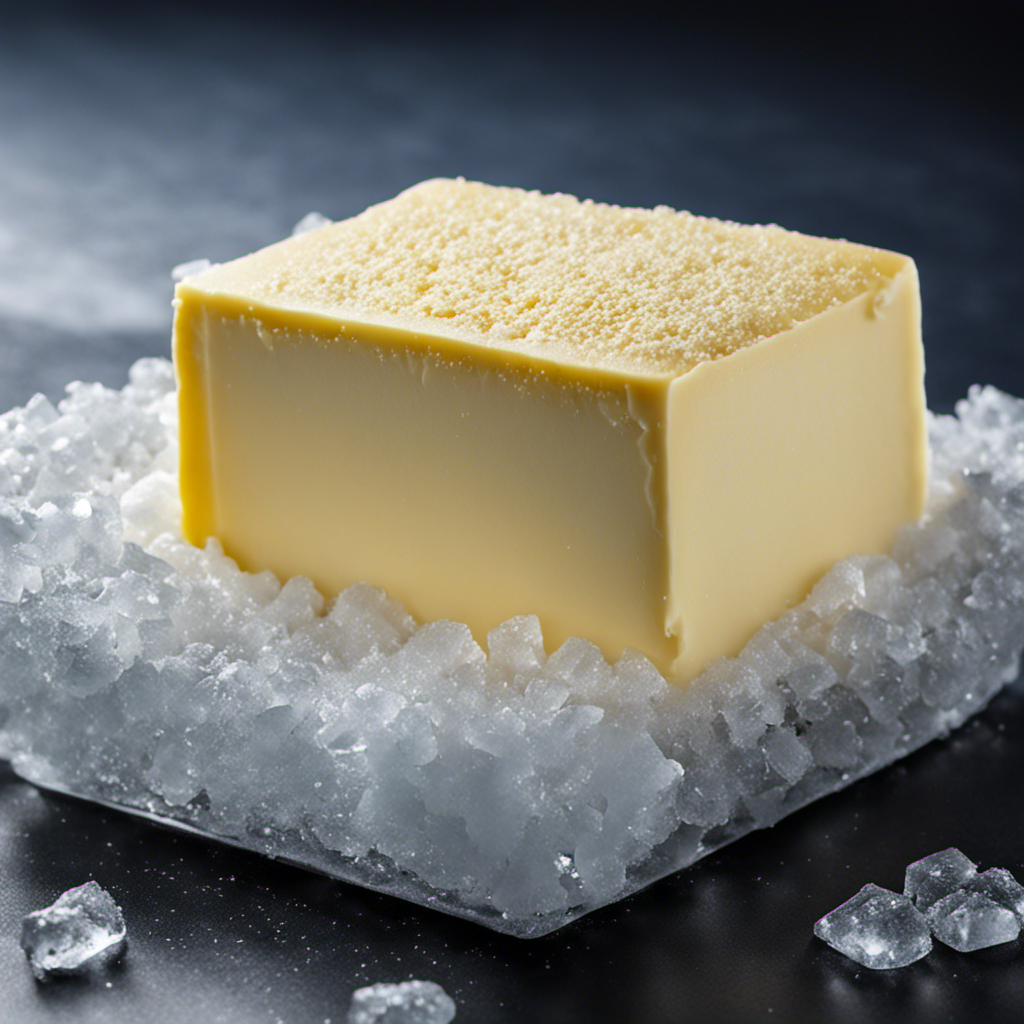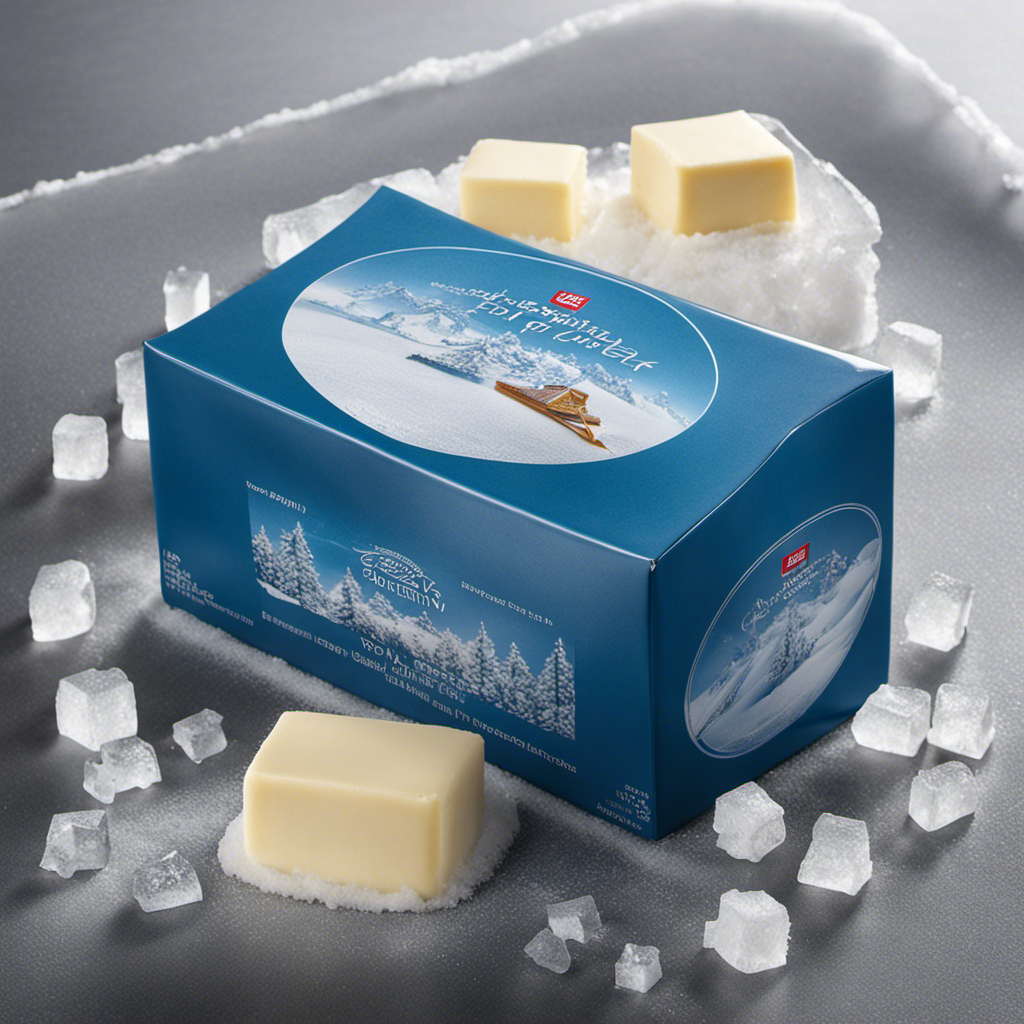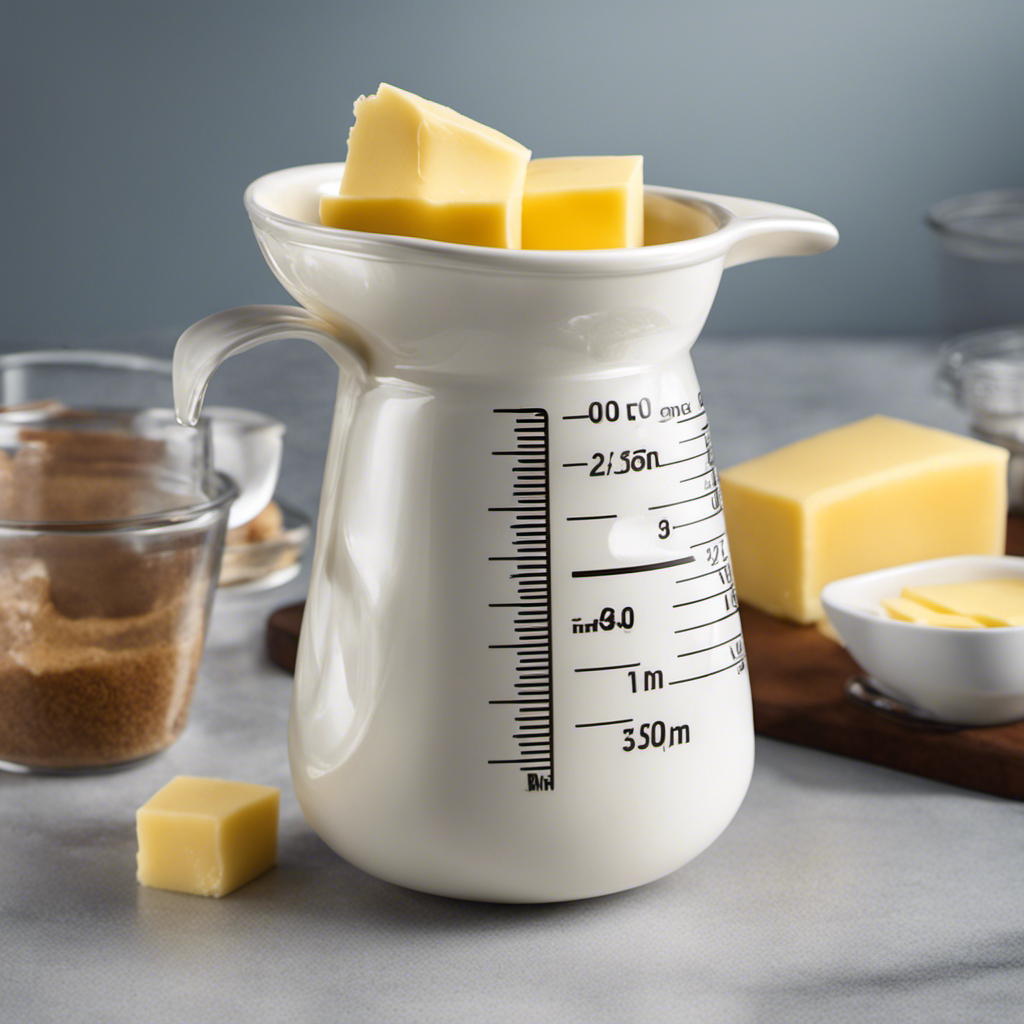As someone who cooks at home, I frequently ponder about the maximum duration butter can be kept in the freezer without losing its integrity. It’s a widespread dilemma faced by many when we end up with more of this adaptable cooking component than we need.
In this article, we’ll explore the optimal freezing period for butter and the factors that can affect its freezing shelf life.
We’ll also discuss best practices for storing butter in the freezer, signs of butter gone bad, tips for thawing and using frozen butter, and even some alternative uses for this freezer-friendly staple.
So, let’s dive in and unravel the mysteries of freezing butter.
Key Takeaways
- Butter can be frozen for up to six months.
- The freezing temperature should be between 0°F and 10°F (-18°C and -12°C).
- Lower temperatures can cause fat separation and altered taste.
- Higher temperatures can lead to off-flavors and rancidity.
Optimal Freezing Period for Butter
You can freeze butter for up to six months. When it comes to preserving butter quality, it is crucial to consider the freezing temperature.
The ideal freezing temperature for butter is between 0°F and 10°F (-18°C and -12°C). At this temperature range, the butter retains its flavor, texture, and quality for a longer period.
Freezing butter at a lower temperature can cause the fat to separate, resulting in a grainy texture and altered taste. On the other hand, if the temperature is too high, the butter may develop off-flavors and become rancid over time.
Therefore, it is essential to maintain the proper freezing temperature to ensure the butter’s quality remains intact during its freezing period of up to six months.
Factors Affecting Butter’s Freezing Shelf Life
Factors like temperature and packaging can affect how long butter can be stored in the freezer. It is important to understand these factors in order to maintain the quality and taste of the butter. One of the key factors affecting butter’s taste is the temperature at which it is stored. Keeping the freezer temperature below 0°F (-18°C) helps to prevent flavor deterioration and maintain the butter’s freshness. Additionally, proper packaging plays a crucial role in preventing freezer burn on butter. Packaging the butter tightly in an airtight container or wrapping it in aluminum foil helps to protect it from exposure to air and moisture, which can lead to freezer burn. By taking these factors into consideration, you can ensure that your butter stays fresh and flavorful for an extended period of time in the freezer.
| Factors Affecting Butter’s Taste | How to Prevent Freezer Burn on Butter |
|---|---|
| Temperature below 0°F (-18°C) | Proper packaging |
| Flavor deterioration prevention | Tightly sealed containers |
| Freshness maintenance | Aluminum foil wrapping |
| Protection from air and moisture | |
Storing Butter in the Freezer: Best Practices
To maintain the freshness and quality of your butter, it’s important to store it in the freezer using proper techniques. Freezing butter without affecting its taste is possible if you follow these guidelines.
First, make sure the butter is tightly wrapped in airtight packaging, such as aluminum foil or freezer-safe containers, to prevent it from absorbing odors or flavors from other foods.
Second, place the butter in the coldest part of the freezer, away from the door, to maintain a consistent temperature.
Lastly, be mindful of the length of time you keep the butter in the freezer. While butter can be frozen for up to a year without significant quality loss, it’s best to use it within six months for optimal freshness.
By preserving butter’s freshness in the freezer with these techniques, you can enjoy the same great taste even after months of storage.
Now, let’s explore the signs of butter gone bad in the freezer.
Signs of Butter Gone Bad in the Freezer
If your butter has developed a rancid or off-putting odor, it may be a sign that it has gone bad in the freezer. Freezer burn is a common issue with frozen foods, including butter. It occurs when the moisture in the butter evaporates, leaving it dry and causing changes in texture and taste.
Freezer burn can also lead to the development of an unusual odor. When butter is exposed to air in the freezer, it can oxidize, resulting in a stale or spoiled smell. To prevent freezer burn and the accompanying odor, it is important to store butter properly in airtight containers or freezer bags.
Additionally, using butter within six months of freezing can help maintain its freshness and prevent the development of an unpleasant smell.
Tips for Thawing and Using Frozen Butter
When it comes to thawing frozen butter, there are a few techniques that I’ve found to be effective.
One method is to simply place the butter in the refrigerator overnight, allowing it to slowly thaw.
Another option is to use the defrost function on a microwave, being sure to check on it frequently to prevent melting.
Once the butter is thawed, there are countless creative uses for it. You can incorporate it into baked goods or use it as a flavorful spread.
Thawing Techniques for Butter
You can easily thaw frozen butter by placing it in the refrigerator overnight. This allows the butter to slowly and evenly thaw, ensuring that it doesn’t melt or become too soft.
However, if you need to thaw the butter quickly, you can use one of the following methods:
-
Microwave method: Cut the frozen butter into small pieces and place them in a microwave-safe bowl. Microwave on low power in 15-second intervals, stirring in between, until the butter is soft and pliable.
-
Water bath method: Fill a bowl with warm water and place the wrapped butter in it. Let it sit for a few minutes until the butter softens. Be careful not to let the water touch the butter directly.
-
Grating method: Grate the frozen butter using a cheese grater. The grated butter will thaw more quickly, making it easier to incorporate into recipes.
Thawed butter is perfect for spreading on toast or using in baking recipes. Now, let’s explore some creative uses for frozen butter.
Creative Uses for Frozen Butter
To add richness and flavor to your mashed potatoes, try incorporating frozen butter into the mixture while it’s still hot. This unique recipe hack not only enhances the taste but also adds a creamy texture to your dish. But did you know that frozen butter has surprising benefits in baking too? When used in pastry dough, the cold butter creates pockets of steam during baking, resulting in a flaky and tender crust. Additionally, it helps to keep the dough from becoming too sticky, making it easier to work with. To give you a better idea, here’s a table showcasing some creative uses for frozen butter:
| Unique Recipes Using Frozen Butter | Surprising Benefits of Frozen Butter in Baking |
|---|---|
| Flaky pie crusts | Enhanced texture and taste |
| Fluffy biscuits | Improved dough handling |
| Buttery croissants | Prolonged shelf life |
Incorporating frozen butter into your cooking and baking can truly elevate your dishes. Now, let’s explore some alternative uses for frozen butter.
Alternative Uses for Frozen Butter
There are many different ways you can use frozen butter in your recipes. Here are three alternative uses for frozen butter that can enhance your baking experience:
-
Baking with frozen butter: When making pastries or pie crusts, using frozen butter can help create a flaky and light texture. By grating the frozen butter into the dry ingredients, it gets distributed evenly, resulting in a beautiful crumb.
-
Preserving butter flavor: Freezing butter can help preserve its fresh flavor for longer periods. By wrapping individual portions of butter in plastic wrap and storing them in an airtight container, you can extend the shelf life and maintain the taste.
-
Making compound butter: Frozen butter can be blended with various herbs, spices, or citrus zest to create flavorful compound butters. These can be used to enhance the taste of steaks, grilled vegetables, or even spread on bread.
Frequently Asked Questions
Can I Freeze Butter in Its Original Packaging?
Yes, you can freeze butter in its original packaging. However, it is recommended to transfer it to an airtight container or wrap it tightly in plastic wrap to prevent freezer burn.
How Long Does It Take for Frozen Butter to Thaw?
When thawing frozen butter, the best method depends on how quickly you need it. Room temperature thawing takes about 1-2 hours, while microwave thawing on low power can take only a few minutes.
Can I Refreeze Butter That Has Been Thawed?
Yes, you can refreeze butter that has been thawed, but it’s best to use it immediately after thawing. Repeated freezing and thawing can affect the quality and texture of the butter.
Can I Freeze Salted Butter?
Yes, you can definitely freeze salted butter! It’s a great way to extend its shelf life, especially if you buy it in bulk. Freezing unsalted butter is also an option.
Can I Freeze Butter in a Glass Container?
Yes, butter can be frozen in a glass container. However, it is recommended to freeze butter in a plastic or silicone container to prevent breakage or shattering.
Conclusion
In conclusion, freezing butter is a convenient way to extend its shelf life. By following proper storage practices, such as wrapping it tightly in plastic wrap or using airtight containers, you can preserve butter for up to six months in the freezer.
While some may argue that frozen butter loses its flavor and texture, it can still be used for cooking and baking purposes. So don’t hesitate to stock up on butter and freeze it, ensuring you always have some on hand when needed.








